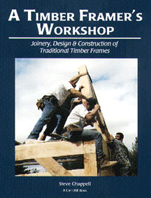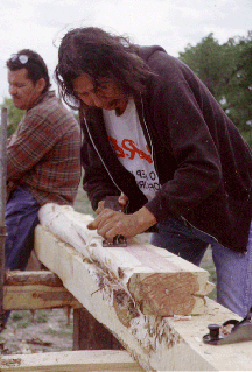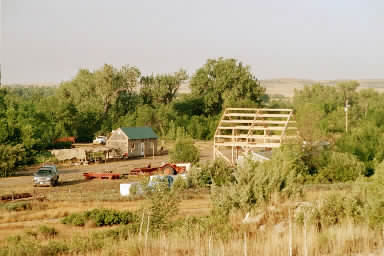|
Fox Maple School of Traditional Building
65 Corn Hill Road, P.O. Box 249 Brownfield, Maine 04010 (207) 935-3720 Contact Us! Home
A Timber Framer's Workshop "Throughout the book, Chappell shares an infectious love of the art and craft of timber framing. A This 250 page workbook includes comprehensive in-depth technical information on the joinery, design and construction of Traditional Timber Frames. Illustrated with over 230 photos and CAD drawings. Included are Frame Plans, design and engineering formulae, rule-of-thumb design and engineering guidelines, shop setup, builder's math, joinery design criteria, practical timber framing tips, tools and more. If you are an architect, engineer, builder or an aspiring owner builder wishing to build your own timber frame, A Timber Framer's Workshop will provide the information you need. |
|
Fox Maple School of Traditional Building
Lakota Timber Framing Workshop
Pine Ridge Indian Reservation
October 6-11, 2003
This workshop is part of Fox Maple's
Indigenous Peoples Community Building InitiativeFox Maple School of Traditional Building began developing its training program with indigenous peoples on the Pine Ridge Indian Reservation in the Fall of 2000. In the interim, the program has expanded to include projects in the mountains of Costa Rica and Kauai, Hawaii. Future projects in Ecuador and Nicaragua are currently under study.
The principal goal of the Indigenous Peoples Community Building Initiative (IPCBI), is to develop a sustainable building infrastructure within indigenous communities utilizing local natural materials and traditional systems and methods of construction. Initially, we go into a community and analyze the natural resource base, traditional building patterns, traditional cultural life-style, current life patterns and economic conditions. Through this we are able to develop a training program that uniquely embraces the communities environmental, cultural and architectural identity.
After completing a thorough survey, we then organize a formal workshop in which a community building is built for and with the people in the community. This includes active participation of from 8 to 12 community members (though a much greater number take part in the process), coupled with 8 to 10 students from outside the community. Primary funding for the building project is generated directly through the tuition paid by outside students. There is no cost to the local community. A unique, multi-cultural educational exchange results, training people in not only the craft of timber framing, but also a variety of natural and traditional building approaches that readily uses their local resources. Through the process a needed structure that embraces these cultural elements evolves. Through this, a viable alternative building model evolves that can then be expanded within the greater community. Success breeds success.
Milling and planing cedar braces, Pine Ridge.
Pine Ridge 2003 Workshop Project October 6,11, 2003
We’ll be returning to Pine Ridge in October to continue work with the community of Slim Buttes. Slim Buttes is in the extreme southwestern corner of the reservation, in one of the remotest and poorest areas of the reservation and in the U.S. For the past three years we have been working closely with Tom Cook, founder and director of the Slim Buttes Agricultural Development Program (SBAG).
SBAG is a community-based organic gardening initiative in which community members are encouraged to create their own solutions to reservation-wide problems of malnutrition and hunger by planting vegetable gardens. SBAG actively engages with the community by sprouting over 20,000 seedlings, tilling and planting nearly 500 gardens each spring.
Fox Maple’s IPCBI projects on Pine Ridge to date have included two 12’x36’ timber framed greenhouses, one in 2000 and another 2001, and a 24’x32’ equipment repair garage/workshop in 2002. One on the greatest problems Cook faces is keeping at least one of their 7 tractors operational at any given time. They need a new tractor, preferably made outside of Russia, and after 1960.
We will return to the Pine Ridge reservation in October 2003 as a continuation of the development of the Slim Buttes site as a community gardening and learning center.
The Slim Buttes Site. 2001 Greenhouse project on left, 2002 frame on right.
What's Included
This is a 6 day course and will include all meals and camping on site in tipis. Full bathing facilities are also available.
Travel to Pine Ridge
Flights can be booked to Rapid City, the largest regional airport, or Chadron, Nebraska. The Slim Buttes site is approx 2 hours drive from Rapid City and 1/2 hour from Chadron. Complete info packet will be mailed upon registration.
If you have any questions or would like more information about this workshop, please email us.
Click here to read Newsletter #12 Article about Pine Ridge
Download pdf file of Newsletter #14 with additional info about Pine Ridge
Download pdf file of Newsletter #15, Summer/Fall 2003
Tuition $775. Limited to 12 students. Registration.
Click below to download IPCBI newsletter in pdf format
Indigenous Peoples Community Building Initiative Newsletter





